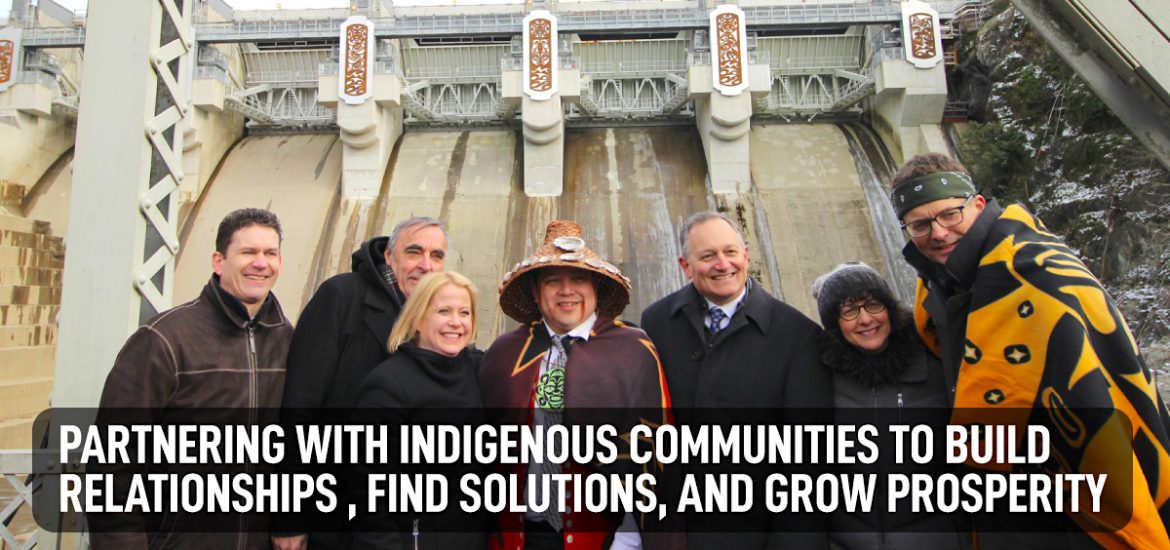
In 1930, the Ruskin Dam was built in the heart of Kwantlen First Nation territory, in an area with significant spiritual and cultural meaning to the Kwantlen people. At that time, the principles of respectful consultation and engagement were not the norm. Reconciliation had not yet begun to be stitched into the fabric of our society. While there remains much work ahead as we collectively advance reconciliation, it is safe to say that we have been making some great progress.
When the Ruskin Dam needed upgrades, it was a priority to ensure that local First Nations were involved and engaged throughout the process. This approach was incredibly significant in light of BC Hydro’s discovery of a 9000-year-old burial site during construction. This started a new kind of dialogue between BC Hydro and the Kwantlen people.
Upgrades were completed last year and I had the great honour of witnessing the unveiling of six new art panels on the Ruskin Dam, designed by Brandon Gabriel from the Kwantlen First Nation. These massive art panels share the history of the Kwantlen First Nation and their connection to the land. One of the most important things that I learned that day from the Kwantlen people is that as a witness to the unveiling of those panels, I now have a responsibility to share this story with others; a story that I am honoured to share here.
What started as an infrastructure upgrade led to an opportunity for the Kwantlen people to share their story with non-indigenous communities. It represents one small step forward on the path of reconciliation – a path we all walk together. We need to engage often, and in meaningful ways, so that we can learn, listen, understand, and ultimately, form long-lasting partnerships with First Nation communities.
Since being elected in 2017 to a constituency on the traditional territories of the Kwantlen and Katzie people, I’m proud of the work we have done in partnership with local First Nations to deliver solutions to needs that have gone unaddressed for far too long.
Since forming government we have announced 39 units of on-reserve housing for Indigenous youth, Elders and families on Katzie territory. Province-wide, we are building more than 1,100 units of on- and off-reserve housing for Indigenous people.
We have seen high school graduation rates among Indigenous youth steadily increase as we deliver new resources, opportunity, and funding.
Through the University of the Fraser Valley and the Maple Ridge Pitt Meadows Katzie Literacy Committee, we are connecting adult learners with the skills they need to build a strong future for themselves.
And we are supporting the revitalization and preservation of Indigenous languages through a $50 million grant to the First Peoples’ Cultural Council.
These are just a few ways we are working to build stronger relationships with First Nations.
We will continue to build on this momentum as we create a reliable, long-term, revenue stream for First Nations by sharing gaming revenue. This stable funding of over $3 billion over 25 years for First Nations will allow for capacity building, financing of infrastructure, education, cultural development and other important priorities.
We will also continue this momentum by introducing legislation this fall that will create a clear, transparent, and accountable path for the implementation of the United Nations Declaration on the Rights of Indigenous Peoples.
We are entering an historic moment in time as the shared political will between the Province and First Nations propel us forward in our reconciliation goals. Building strong partnerships gives us the unique opportunity to make a difference on a host of issues.
Reconciliation is a journey and not a destination. It will be a learning process. But, we are committed to finding ways to work better together and to make life better for people in Indigenous and non-Indigenous communities throughout British Columbia.

